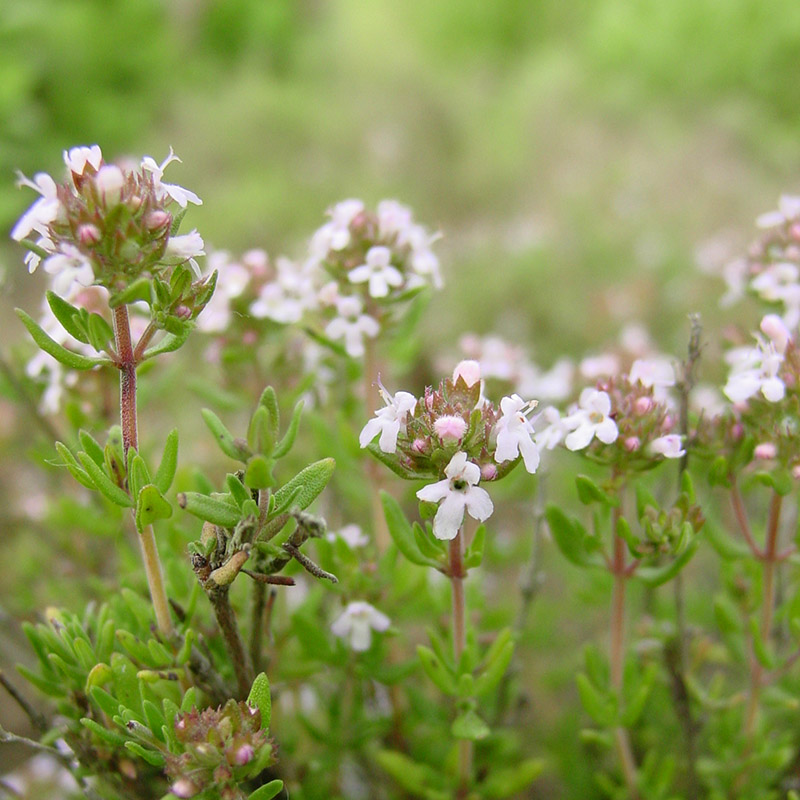Botanical name
Thyme - Thymus vulgaris L.
Family
Lamiaceae
Common name
Garden thyme, Common thyme
Information about the plant
Thyme is mainly distributed in the Mediterranean region from Spain to Italy, from where it reached Central Europe in the early Middle Ages through the Alps. Today, it is cultivated in many parts of Europe. There is no consensus on the origin of the genus name Thymus. It could come from the Greek word 'thumos' (= courage, strength), or it could be attributed to the Greek word 'thymiama' (= incense), as the plant was used for its aromatic scent in burnt offerings. The German name "Thymian" is a variation of the scientific genus name. The species epithet is Latin and means "common".
Thyme is an aromatic dwarf shrub with small leaves, hairy on the underside and with a downward-rolled leaf edge, giving the leaves a needle-like appearance. The pink-violet flowers are arranged in whorls in a spike or head shape. The flowering time varies from June to September, depending on the region. The characteristic spicy scent of thyme comes from the essential oil thyme oil. It is found in glandular scales on the leaf surface and is released once these glands are damaged after rubbing the leaves.
Medicinally used parts of plants (herbal drug)
The thyme herb (Thymi herba) is used with its spicy smell, which is clearly perceived when rubbed and is caused by the essential oil contained therein. The commercially available drug comes mainly from Germany, and smaller quantities come from Spain and Morocco.
The essential oil (thyme oil - Thymi aetheroleum), which is obtained from thyme herbs by steam distillation, is also used. The main suppliers of thyme oil are Spain and France.
Constituents of the herbal drug
The thyme herb contains a volatile oil ("thyme oil"). It contains 30 to 50% thymol, 10 to 20% p-cymene, γ-terpinene 50-10%, and other monoterpenes. In addition, it contains lamiaceous tannins (main representative: rosmarinic acid) and flavonoids. The characteristic scent of the oil is due to thymol.
Quality of the drug
The quality of the following drugs or drug preparations is specified in the European Pharmacopoeia (Ph. Eur.)
- Thyme (Thymi herba)
- Thyme oil of the thymol type (Thymi typo thymolo aetheroleum)
The quality of thyme fluid extract (Thymi extractum fluidum) is specified in the German Pharmacopoeia (DAB).
The quality of thyme tincture (Thymi tinctura) is specified in the German Pharmacopoeia Codex (DAC).
Medical applications
Recognised medical use
The HMPC has classified thyme herb as a traditional herbal medicinal product (see "Traditional use”).
ESCOP: Catarrh of the upper respiratory tract, bronchitis and supportive in whooping cough; in the form of mouthwashes for inflammation of the oral mucosa and bad breath.
The HMPC has classified thyme oil as a traditional herbal medicinal product (see "Traditional use").
Traditional use
The HMPC has categorized thyme herb and thyme oil as traditional herbal medicinal products (§ 39a AMG). Based upon long-standing use, thyme herb and thyme oil can be used internally as a mucolytic agent (expectorant) for cold-related coughs. The external application of thyme oil (liniments, baths) is used to relieve cold symptoms.
Herbal drug preparations in finished dosage forms
- Thyme herb as a tea, in tea bags, in mixtures with other drugs
- Thyme fluid extract juices (cough syrup), drops (cough drops) and other liquids
- Thick extract in juice (cough syrup)
- Alcoholic and aqueous extracts in drops
- Dried extract in capsules
- Thyme oil in baths (colds), ointments (cold creams) and soluble instant teas
Dosage
Finished medicinal product: see patient information leaflet.
Tea: drink 1 cup of freshly prepared thyme tea warm several times a day.
Thyme fluid extract: 1 to 2 g fluid extract 1 to 3 times a day.
Preparation of a tea
Pour 150 ml of hot water over 1.5 to 2 grams of thyme (do not boil!). Let it stand for 10 minutes and strain.
Notes
In infants and children up to 2 years of age, thyme oil can trigger a glottis spasm (laryngospasm), in the worst case with respiratory arrest, so never apply thyme oil to the face!
Thyme oil should not be directly applied to mucous membranes or broken skin, and never around the eyes. Full baths with thyme leaves or thyme oil should be avoided in large open wounds and skin lesions, fever, severe infections, severe vascular diseases, and heart failure.
There are no safety studies on the use of thyme during pregnancy or lactation.
The use of liquid thyme preparations in children under 4 years of age is not recommended due to a lack of evidence; this applies to the use of thyme oil in children and adolescents under 18 years of age.
Side effects
Very rarely: hypersensitivity reactions, such as shortness of breath, skin reactions, and swelling.
Interactions
None known.
References
Herbal drug monographs
HMPC (2014, 2020), ESCOP (2009), WHO (Vol. 1, NIS)
Further literature
Commentary on the European Pharmacopoeia (Thyme, Nr. 0685; Thyme oil, Nr. 1374)
Commentary on the German Pharmacopoeia (Thyme fluid extract)


